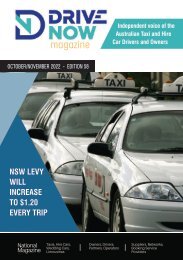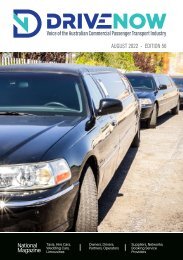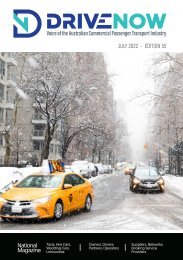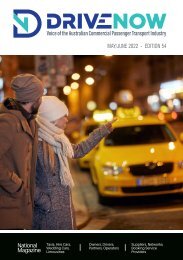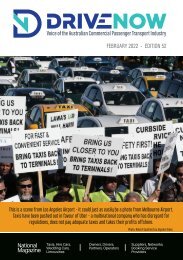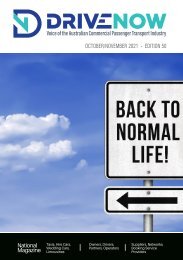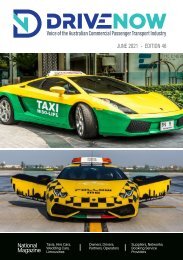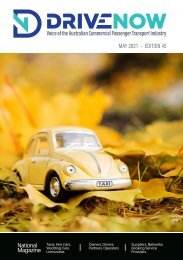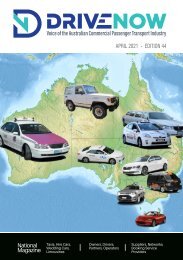DRIVE NOW August 2021
*** SCROLL DOWN TO SELECT ALTERNATIVE MAGAZINE EDITIONS *** Australia's only Magazine for the Commercial Passenger Transport Industry. News and views for Drivers, Owners and Operators of Taxi, Hire Car, Limousine, Ride Share, Booked Hire Vehicles, Rank and Hail Cars.
*** SCROLL DOWN TO SELECT ALTERNATIVE MAGAZINE EDITIONS ***
Australia's only Magazine for the Commercial Passenger Transport Industry. News and views for Drivers, Owners and Operators of Taxi, Hire Car, Limousine, Ride Share, Booked Hire Vehicles, Rank and Hail Cars.
You also want an ePaper? Increase the reach of your titles
YUMPU automatically turns print PDFs into web optimized ePapers that Google loves.
As I have discussed, there is a clear<br />
quandary in this statement. What<br />
if a passenger is unable to check<br />
in? Does this betoken the driver<br />
will lose their work in this already<br />
struggling economy?<br />
Also, the NSW government states<br />
“If a passenger refuses to check in,<br />
the driver may deny the passenger<br />
entry to the vehicle.”<br />
Tasmania<br />
Tasmania has recently taken the<br />
same outlook as NSW where it<br />
highlights “everyone who gets<br />
into your taxi, ride share, luxury<br />
hire or restricted hire vehicle, with<br />
or without a booking, is required<br />
to scan the business’ QR Code on<br />
entry”.<br />
South Australia<br />
South Australia has also jumped on<br />
the QR Code bandwagon and states<br />
“any person or entity responsible<br />
for the operation of a point-to-point<br />
service must ensure their vehicles are<br />
equipped with their own COVID SAfe<br />
Check In QR Code. And all drivers<br />
must ask or encourage passengers to<br />
check in via QR Code”.<br />
Queensland<br />
In contrast, the Queensland<br />
government doesn’t specifically<br />
reference taxis, ride share vehicles,<br />
hire cars or anything of the sort in<br />
their statements. However, as a<br />
broad overlook it seems to convey<br />
that it is mandatory for all business<br />
types to have and enforce the usage<br />
of QR Codes. There has been a<br />
great call in recent weeks to make<br />
QR Codes mandatory in vehicles<br />
operating in the Personalised<br />
Transport sector.<br />
Western Australia<br />
Comparably, Western Australia<br />
does not mention any part of the<br />
On Demand Transport industry with<br />
reference to QR Codes.<br />
This means it has not made it<br />
mandatory for taxis and ride share<br />
operators to have a QR Code<br />
displayed in their vehicles. Instead<br />
some businesses, i.e. Premier,<br />
Legion, GM Cabs and regional<br />
operators, have registered with<br />
and printed Service NSW (that’s<br />
right – NSW) app’s QR Code, thus<br />
allowing taxi drivers and passengers<br />
to register their details.<br />
Northern Territory<br />
In Northern Territory there is<br />
currently no requirement for taxis or<br />
ride share vehicles to have QR Codes<br />
displayed or used for check-ins.<br />
ACT<br />
Recently, Canberra announced that<br />
use of the CBR app is mandatory in<br />
supermarkets, department stores,<br />
petrol stations, take away services,<br />
public transport and all ride-sharing<br />
services including taxis and Uber.<br />
Conclusion<br />
QR Codes should always be available<br />
to all users of taxis, ride share<br />
and other mediums of transport!<br />
However, their usage – whilst highly<br />
recommended – shouldn’t be made<br />
mandatory as it signifies possible<br />
work loss for drivers.<br />
by Isobel Sparrow<br />
www.drivenow-magazine.com.au<br />
<strong>August</strong> <strong>2021</strong><br />
9




